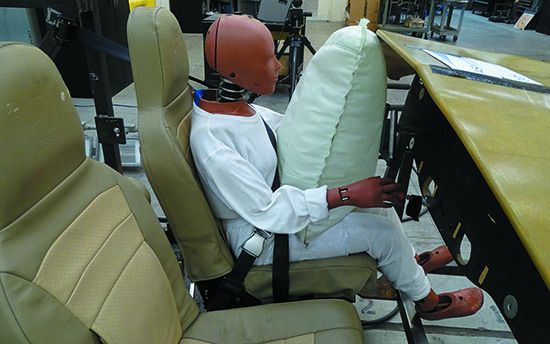
As aviation learned from the automotive world, airbags that deploy within milliseconds of the beginning of an impact event and keep the occupant from slamming into the panel have saved countless lives. The initial challenge for the aircraft world was where to store the airbags and how to deploy them. I looked at records and spoke with engineers at one of the airframe manufacturers regarding their airbag work in the 1970s.
The overriding problem was how to avoid having the airbag impact the flight control system, causing potential loss of control during an inadvertent deployment as we’ll as to make sure that a deployment during an impact sequence didn’t cause a flight control input that made matters worse. At the time, the only places to put the airbags were in the instrument panel or control yoke, and even in an aircraft with a stick rather than a yoke, deployment did bad things with the flight controls.
Shortly after the turn of the century, AmSafe (www.amsafe.com) developed and began marketing a system for general aviation aircraft in which the airbag was stored in the seatbelt and/or shoulder harness. The company custom designed the systems for individual types of aircraft and went through the process of FAA approval. Each airbag was tailored for the space available in front of the occupant of the particular type of airplane. That required designing the system to work on everyone from the smallest 5th percentile adult female through the largest 95th percentile adult male.
AmSafe also had to demonstrate that an inadvertent deployment would not adversely affect control of the aircraft and would not knock the pilot’s hand off of the yoke or stick. Further, AmSafe had to demonstrate that the risk of inadvertent deployment approached zero.
AmSafe’s custom seatbelt airbags are approved for installation in over 150 types of aircraft and are standard equipment in many new aircraft.
The retrofit custom systems cost north of $5,000 for the front two seats. We were told by shops that had performed the retrofit that installation varied with the type of aircraft and ran between eight and 40 hours per seat.
The cost of the retrofit, the fact that it was not possible to install shoulder harnesses on some general aviation airplanes and the increasing number of saves by airbag-equipped seatbelts caused AmSafe to see if there were a way to design and get approval for a seatbelt airbag system that could be installed in any general aviation aircraft.
At the same time, the FAA’s Anchorage office had been working with industry to try and reduce the high general aviation accident and fatality rate in Alaska. It reached out to AmSafe. AmSafe developed, and the FAA approved, an airbag system that could be installed on virtually any seat in any general aviation airplane type certificated prior to the FARs requiring 26-G seats. Significantly, it could be used on seats where a shoulder harness could not be installed. As can be seen from the photo below, in use, it functions as a shoulder harness—keeping the occupant’s upper torso restrained during an impact.
The new system, SOARS (State-of-the-Art Restraint System), is offered for $2,580 for two seats, less than half the price of the bespoke systems. Installation takes three to six hours.
When we spoke with AmSafe, we were told that SOARS is approved for installation on 423 types of aircraft. It can be used to replace two-, three-, four- and five-point restraints. The list of approved aircraft and the installation instructions are on AmSafe’s website. We note that the FAA approval documents do not limit the installation to front seats.
The system deploys when the crash sensor detects a longitudinal force at or above 6 Gs for approximately 50 milliseconds. The seatbelt airbag deploys upward, not into the face of the occupant. The crash sensor and systems electronics are contained with an Electronic Module Assembly (EMA) that is powered by a non-rechargeable lithium battery. The battery and inflator must be replaced after 10 years. Otherwise maintenance is only required during the annual, no special tools are needed and the EMA has a push-to-test switch that reads out the health of the system. The electronics are independent from the aircraft’s electrical system.
SOARS may be installed by an A&P and only needs a Form 337. Each kit includes a foam body block sized for a 50th percentile adult to allow the airbag to be adjusted to the correct position on the seatbelt.
AmSafe’s website has a number of videos showing deployment of SOARS and that while a double-over-the-shoulder belt system is truly a lifesaver, an airbag is even better at protecting an occupant from flail injuries and hyperextension of the neck.




